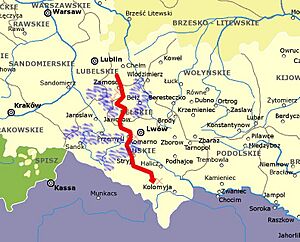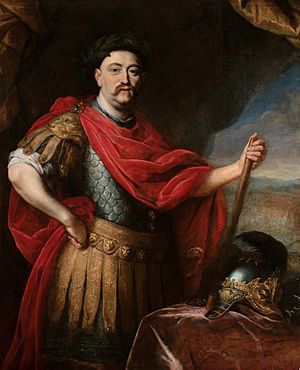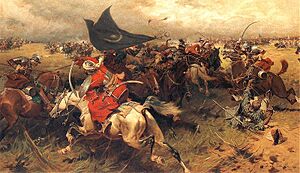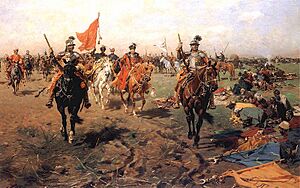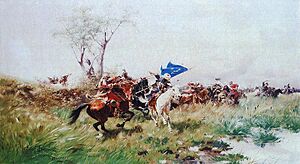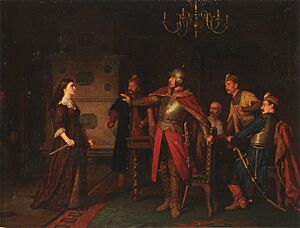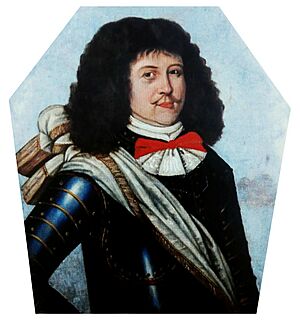Polish–Ottoman War (1672–1676) facts for kids
Quick facts for kids Polish–Ottoman War (1672–1676) |
|||||||||
|---|---|---|---|---|---|---|---|---|---|
| Part of the Polish–Ottoman Wars | |||||||||
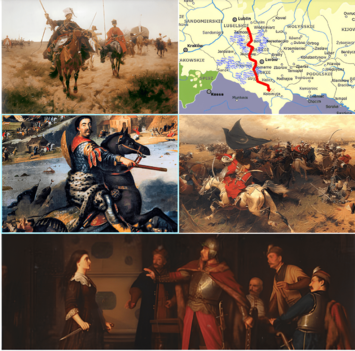 From top left:
|
|||||||||
|
|||||||||
| Belligerents | |||||||||
| Commanders and leaders | |||||||||
| John Sobieski Michał Kazimierz Pac Mykhailo Khanenko |
Mehmed IV Köprülüzade Fazıl Ahmed Kara Mustafa Pasha Selim I Giray Petro Doroshenko |
||||||||
| Strength | |||||||||
| 12,000 Crown troops and 5,400 Lithuanian troops After 17 October 1672 troops were increased to 31,000 and with the 12,000 Crown and Lithuanian troops including militiamen and private troops the forces available for campaign numbered nearly 60,000 |
40,000 to 60,000 | ||||||||
The Polish–Ottoman War of 1672–1676 was a big conflict between the Polish–Lithuanian Commonwealth and the powerful Ottoman Empire. It was a preview of an even larger war called the Great Turkish War. This war ended with the Treaty of Żurawno. In the end, the Commonwealth had to give up most of its lands in Ukraine to the Ottomans.
Contents
- Why the War Started: A Look at the Causes
- The First Attack: Ottoman Invasion of 1672
- The Second Phase: Poland Fights Back (1673–1676)
- The End of the War: Treaty of Żurawno
- What This War Meant for Poland
Why the War Started: A Look at the Causes
The reasons for this war go back to 1666. A leader named Petro Doroshenko, who was the Hetman of the Zaporizhian Host (a group of Cossacks), wanted to control Ukraine. He was losing battles to other groups fighting for the same land. To keep his power, he made a deal with the Ottoman Sultan Mehmed IV in 1669. This deal made the Cossack Hetmanate a part of the Ottoman Empire.
At the same time, the Commonwealth was trying to calm down problems in Ukraine. But their army was weak from many years of fighting. These wars included the Khmelnytsky Uprising, The Deluge, and the Russo-Polish War (1654–1667).
The Tatars, who often raided Commonwealth lands for treasure, saw this weakness. They teamed up with Doroshenko's Cossacks and invaded. But a Commonwealth leader named John Sobieski stopped them. He defeated them many times between 1666 and 1667. They finally agreed to a ceasefire after the Battle of Podhajce.
In 1670, Doroshenko tried again to take over Ukraine. In 1671, the Ottoman Sultan replaced the Khan of Crimea, Adil Giray, with a new one, Selim I Giray. The new Khan joined forces with Doroshenko's Cossacks. But again, Sobieski defeated them. Selim then promised loyalty to the Ottoman Sultan and asked for help. The Sultan agreed. This is how a small border fight grew into a full war in 1671. The Ottoman Empire was now ready to send its main army to take control of the region.
The First Attack: Ottoman Invasion of 1672
In August 1672, a huge Ottoman army of 80,000 soldiers invaded Polish Ukraine. They were led by Grand Vizier Köprülü Fazıl Ahmed and Sultan Mehmed IV. They quickly captured the Commonwealth fortress at Kamieniec Podolski. Then, they surrounded the city of Lwów.
The Commonwealth was not ready for war. Its leaders, the king Michael I and the szlachta (nobility), were fighting among themselves. The Commonwealth Parliament could not agree to raise taxes or gather a bigger army. Because of this, their representatives had to sign the Peace of Buczacz in October 1672.
This treaty gave a large part of Ukraine to the Ottomans. This included the Right-bank areas of Bracław, Podole, and part of Kiev. The Left-bank Ukraine was already controlled by Russia. The Commonwealth also had to promise to pay a yearly tribute of 22,000 gold coins.
The Second Phase: Poland Fights Back (1673–1676)
Instead of accepting the peace treaty, the Commonwealth Parliament was very angry about losing land and having to pay tribute. They felt it made them look like a vassal (a weaker state controlled by a stronger one). So, they finally agreed to raise taxes for a new army. This army grew to about 37,000 soldiers. They also increased the number of Cossacks officially serving the Commonwealth to 40,000.
Hetman John Sobieski led this new army. He launched military campaigns against the Ottomans and won several important battles.
Sobieski's Amazing Expedition Against the Tatar Raiders
After taking Kamieniec Podolski, the Ottoman army began to surround Lwów on September 20. At the same time, the Tatars were not part of the main siege. Instead, they were helped by Hetman Petro Poroshenko's Cossacks and some Ottoman soldiers. They split into three groups and attacked the Polish-Lithuanian Commonwealth.
One group, led by Jiambet Giray, was active between the Wieprz and San rivers. Another, led by Nurredin-Sultan, was south of the Dniester river. A third group, led by Haci Giray, operated near the Vistula and middle San rivers, reaching as far as Jasło. In total, these groups had about 20,000 soldiers spread out across the land.
Sobieski's Swift Attack
Grand Hetman of the Crown John III Sobieski had only about 2,500 to 3,000 cavalry and dragoons. On October 5, he quickly moved from Krasnystaw to attack the Tatars. He traveled light, without heavy wagons, and each soldier had two horses. He went behind the Tatar groups, heading towards Zamość. That night, he crushed a small Tatar group in the Battle of Krasnobród. On October 6, he defeated two more groups in the Battle of Narol. On October 7, in the Battle of Nemirów, he caught and defeated Jiambet's forces.
After a short rest on October 8, Sobieski continued his chase. On October 9, he caught and defeated Nurredin-Sultan's main forces in the Battle of Komarno. He chased them all the way to Vyshnia. On October 11, Sobieski's troops crossed the Dniester river. They continued to chase the retreating Haci Girey. After a very hard day and night march, the Polish army (only about a thousand soldiers could keep up) caught the Tatars at dawn on October 14. They defeated them in battles at Petranka and Kalush.
The Amazing Results of the Expedition
John Sobieski, leading his cavalry and dragoons, rode about 450 kilometers in just 9 days. The Polish soldiers worked incredibly hard. They freed about 44,000 people who had been captured by the Tatars for slavery.
Sobieski, who was in charge, used a very smart tactic. He would send a small group of a few hundred horsemen to attack the Tatars. This would distract them from the main Polish forces coming from another direction. This method always helped them defeat the Tatars and stopped the Tatars from surrounding the Polish army. This amazing success with such a small force happened because Sobieski always chose the right direction to attack. His fast-moving Polish troops used Tatar marching techniques to catch and defeat individual enemy cavalry groups.
The Battle of Khotyn: A Great Victory (1673)
In early November 1673, the Polish-Lithuanian army, with about 30,000 soldiers, surrounded the Khotyn fortress. This army was led by Grand Crown Hetman John Sobieski. The fortress was naturally strong, located in a bend of the Dniester River. Earth walls and many defenses protected it from the land side.
Sobieski's first attacks on November 10 were just to check the enemy's positions. The real battle happened the next day. Sobieski attacked the Turks when they were tired from the cold weather and lack of sleep. The weather was freezing, and the Turks were not ready for such cold conditions.
After a night of preparing for the attack, in strong winds and bitter cold, Sobieski personally led his troops to storm the Turkish camp at dawn on November 11. After a cannon blast, the infantry and dragoons attacked the walls. They pushed back the enemy and made way for the cavalry. Then, the hussars, led by Hetman Jabłonowski, charged through gaps in the walls.
The Turks fought back with their cavalry, but they could not stop the brave hussars. Soon, the fighting was inside the fortress and the Turkish camp, among the tents. The Turkish troops panicked. Hussein Pasha ordered an escape to the other side of the Dniester. But the only bridge at Khotyn was damaged by Polish-Lithuanian cannons. It collapsed under the weight of the fleeing soldiers. Only a few thousand Turks out of their 35,000-strong army managed to reach Kamieniec Podolski.
Most of the other Turkish soldiers were killed or captured. The Polish-Lithuanian army had much fewer losses. They captured a very strong fortress with lots of food and war supplies.
The Battle of Khotyn was a complete victory for the Polish–Lithuanian Commonwealth. However, it did not completely change the war or help them get back Kamieniec Podolski. But it did make the Commonwealth more respected in Europe. And John Sobieski gained great respect from the Turks, who called him the "Lion of Khotyn."
What Happened After Khotyn
The Ottoman army suffered huge losses in this battle. Two-thirds of their soldiers were either killed or wounded. Also, the Moldavian and Wallachian troops switched sides to support the Commonwealth. The Turkish forces left Poland after losing their supplies and most of their cannons. But they still held most of western Ukraine.
Sobieski and the nobles went back to Warsaw for elections. This was because King Michael Wisniowiecki, King of Poland had died the day before the battle.
Sobieski Becomes King and Continues Fighting
After his victory at Khotyn, Sobieski took control of Moldavia and most of the disputed Ukrainian lands. In 1674, King Michael I of Poland died. Because of his victories and dedication, John Sobieski was elected king of the Commonwealth in 1674.
However, over the next year, the Polish army became weaker. The Parliament again refused to raise taxes and pay the soldiers. This led to many soldiers leaving the army because they weren't paid. Polish problems got worse because Hetman Michał Kazimierz Pac was not a good leader and made it harder for Sobieski to lead. Meanwhile, the Ottomans kept getting more soldiers.
Even so, in 1674, the Commonwealth started attacking again. They took advantage of a new war between Russia and Turkey that year. The Polish-Ottoman war continued without a clear winner.
The Battle of Lwów: Sobieski's Clever Defense (1675)
In early summer 1675, Ottoman forces led by Ibrahim Şişman (also known as Abraham the Fat) crossed into Poland. They quickly marched towards Lwów along the Dniester River. This army had about 20,000 soldiers. It was made up of Ottoman infantry and cavalry, along with many Crimean Tatar soldiers.
The Polish king John III Sobieski decided to gather his troops in and around Lwów. He planned to face the attacking Muslim army after more soldiers arrived. The Ottoman commander learned about this and moved his army towards Lwów.
Sobieski made a smart plan. He split his forces. A small group of 180 infantry, 200 light cavalry, and some cannons were placed in the easternmost valleys leading to the road to Lwów. Most of the heavy cavalry were placed directly on the road, behind these valleys. The left side of his army was protected by 200 Hussars in the village of Zboiska. The rest of the light cavalry and infantry guarded all other ways into the city. This was in case the Ottomans tried to go around them and attack from other directions.
The remaining support troops and civilians were told to gather on the hills around the plains. They were given extra lances from the Hussars. This was to make it look like there were many more Polish soldiers than there actually were.
The Battle Begins
The Ottomans advanced exactly as Sobieski had predicted. They thought a large group of Hussars was hiding in the woods on the hills. So, Ibrahim Shyshman sent a strong group of cavalry to reach the road through one of the valleys. Polish infantry stopped them, and then light cavalry pushed them back. At the same time, Sobieski ordered all troops guarding other ways into the city to join the main forces on the road.
A group of 1,700 Polish hussars was joined by 300 Lithuanian light cavalry led by hetman Michał Kazimierz Radziwiłł. Sobieski ordered this cavalry group to advance through an unguarded western valley. This valley was narrow, so the Ottomans could not go around the Polish and Lithuanian cavalry while they were moving.
The battle ended quickly with Sobieski personally leading the charge. The Poles chased the Ottoman cavalry until it got dark.
The Brave Defense of Trembowla (1675)
The castle in Trembowla was built in the 14th century. It stood on a high hill above the Hniezna river valley. Even though it was small (100 meters by 40 meters), it was a strong fortress with walls up to 4 meters thick. After the Turks captured Kamieniec Podolski (see Siege of Kamieniec Podolski), Trembowla was one of the few strongholds in Podolia still held by the Poles.
In the summer of 1675, a 30,000-strong Turkish-Tatar army led by Ibrahim Shyshman entered Red Ruthenia, a part of the Polish–Lithuanian Commonwealth. On July 27, they captured Zbaraz. On September 11, they took Podhajce. By September 20, the Turks were at Trembowla.
The castle was defended by a small group of 80 infantry soldiers. Some local nobles and 200 poorly armed, untrained peasants and town residents also helped. These people had fled to the castle for safety. Before the siege, a unit of dragoons was there, but they were ordered to leave because of food shortages.
Polish forces were led by Captain Jan Samuel Chrzanowski. His wife, Anna Dorota Chrzanowska, became famous after the siege for her bravery.
A Wife's Courage
Despite the Ottoman attacks, the castle defenders held their ground. But after several days, food and water became very scarce. Captain Chrzanowski decided to surrender. His wife, Anna Dorota, strongly disagreed. She threatened to take her own life if her husband surrendered. This made him change his mind and decide to keep defending the castle.
Anna Dorota also encouraged the defenders to attack the Ottoman positions. This surprise attack caused heavy losses for the invaders. Her determination boosted the morale of the Poles, but they also suffered many losses. By the night of October 4/5, only 20 soldiers were still able to fight.
The Turks learned that Jan III Sobieski's forces were gathering near Lwow. Facing this new danger, the Turks decided to end the siege on October 11.
Even after the Battle of Trembowla, the Parliament still refused Sobieski's requests for more money and a larger army.
The End of the War: Treaty of Żurawno
In 1676, Sobieski's army of 16,000 soldiers held out for two weeks against 100,000 men led by Ibrahim Pasha at Żurawno. After this, a new peace treaty was signed, called the Treaty of Żurawno.
This treaty partly reversed the earlier one from Buczacz. The Ottomans kept about two-thirds of the lands they had gained in 1672. But the Commonwealth no longer had to pay any tribute to the Ottoman Empire. Also, many Polish prisoners were released by the Ottomans.
The Parliament rejected this treaty, partly because Austrian diplomats and Pope Innocent XI influenced them. Sobieski was also forced to reduce his army from 30,000 to 12,000 soldiers.
What This War Meant for Poland
This war showed that the Commonwealth was becoming weaker and more disorganized. By the second half of the 17th century, it had started a slow decline. This decline would lead to the partitions of Poland about a century later.
The Parliament was often difficult to control. It was paralyzed by the liberum veto (a rule that allowed any member to block a law) and by foreign bribes. Politicians often thought only about short-term gains. They constantly refused to give money to raise an army. This was because it seemed that most of the Commonwealth would not be attacked by the Ottoman armies.
Even after the bad Buczacz treaty, which convinced the Parliament to raise taxes, they couldn't be convinced to keep fighting after initial successes. Soldiers were not paid, and many left the army. This made the Polish cause weaker. This clear inability to defend itself, also seen in other wars the Commonwealth was in, made other countries more likely to attack the Commonwealth.
On the Polish side, much of the fighting was done by an army that John Sobieski paid for himself. He became known as a skilled, brave commander and a true patriot. He used some of his own money to defend the Commonwealth. In 1674, he was elected King of Poland and ruled as John III.
Sobieski's fame also reached the Ottoman Empire. His victory several years later at the Battle of Vienna would make him known as the best commander fighting the Ottomans. However, even he could not stop the Commonwealth from declining or make the changes needed to save the country.
The Commonwealth did get back the lands it lost in this war after the Polish–Ottoman War (1683–1699) in the 1699 Treaty of Karlowitz. But that was one of its last victories.


